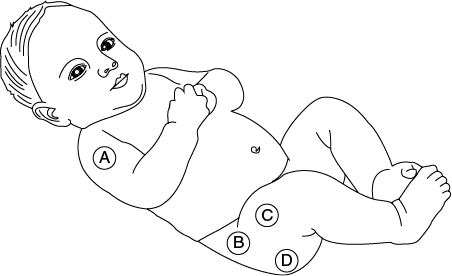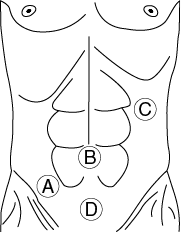Answers and Explanations
Chapter Quiz
- The Answer is 2, 3, and 5
The LPN/LVN is reinforcing teaching for a client after a right mastectomy and axillary lymph node dissection. Which statement by the client requires further intervention by the LPN/LVN? Select all that apply.
Strategy: First, identify the topic of the question. If unable to identify the topic after reading the question, read the answers for clues. All answers relate to prevention of lymphedema. Note that the client had a right mastectomy. When a question includes a reference to left or right, that is often important for identifying the correct answer.
Then, rephrase each answer choice as a “yes/no” question that asks “Will this action by the client prevent lymphedema?” Be careful! The question asks which statements require further intervention by the LPN/LVN. You are looking for incorrect statements.
Category: Evaluation/Physiological Integrity/Reduction of Risk Potential
- Will wearing gloves and long sleeves while gardening prevent lymphedema? Yes. Any injury to the right arm, including insect bites or scrapes, may become infected and cause lymphedema. This is a correct action. Eliminate.
- CORRECT: Will arm swelling decrease one year after the mastectomy procedure? No. The client is at risk for lymphedema for the rest of her life. This statement is not true. Select this answer.
- CORRECT: Will arm elevation on a small flat pillow decrease the risk of lymphedema? No. The arm should be elevated above the level of the heart at night. It is an incorrect action. Select this answer.
- Arm heaviness is a sign of lymphedema development. Client instruction includes notifying primary health care provider if the involved arm feels heavy, has decreased muscle function, or has numbness and tingling. This is a correct action. Eliminate.
- CORRECT: Will a client need to wear a compression bandage for the rest of her life? No. Compression bandages may be used if the client develops acute lymphedema. Compression bandages are not routinely used after mastectomy and lymph node dissection. Select this answer.
- The Answer is 2, 1, 5, 4, 3
The LPN/LVN is preparing to reinforce instructions for a client about the use of an incentive spirometer. Arrange the following steps in the order the client should perform them. All options must be used.
Strategy: Picture the client using the incentive spirometer. What is the purpose of incentive spirometry? To open the alveoli and lower airway passages and increase oxygenation. What position enables the client to inhale deeply to promote lung expansion? The upright position (2).
Now think about the steps used for incentive spirometry. Before the client inhales through the mouthpiece, there must be a tight seal (1). To make the volume indicator move, the client must inhale slowly and deeply (5). To achieve maximum expansion of the lungs, the client should hold the inhalation for 3 to 5 seconds (4). The last step is slow exhalation (3), which will continue to promote expansion of the lower airways.
Category: Planning/Physiological Integrity/Reduction of Risk Potential
- Assume high Fowler’s position.
- Seal lips around the mouthpiece.
- Inhale slowly and deeply.
- Hold breath for 3 to 5 seconds.
- Exhale slowly and cough.
- The answer is 31
The LPN/LVN is preparing to infuse 1 L of normal saline solution at a rate of 125 mL/hr. The drop factor for the intravenous tubing is 15 drops per mL. What is the drip rate per minute? Round to the nearest whole number.
Strategy: Apply the conversion equations, being careful to avoid calculation errors. Only the numerical drip rate should be recorded. Note that specific rounding instructions are given.
Category: Planning/Physiological Integrity/Pharmacological Therapies
The formula is:

For this problem, you need to convert the hour to 60 minutes:

Round to the nearest whole number. The correct answer is 31.
- The Answer is 3
The LPN/LVN is preparing to administer an intramuscular injection to a 6-month-old client. Identify the area where the injection should be given.

Strategy: To answer this hot spot question, recall the age of the client (6 months old) and the preferred site for intramuscular injections in infants (the vastus lateralis muscle in the thigh). Then think about the anatomical landmarks necessary to locate the correct site.
Category: Implementation/Physiological Integrity/Pharmacological Therapies
- A: The deltoid muscle is not the correct location.
- B: The hip is not the correct location.
- CORRECT: Location C is correct. For infants, IM injection should be given in the middle third of the anterior thigh, between the midline anterior thigh and the midline lateral thigh. To identify the IM injection site, locate the greater trochanter, then the knee joint; divide the area between the trochanter and the knee joint into thirds and note the middle third; then locate the area between the midline anterior thigh and the midline of the outer aspect of the thigh.
- D: The buttock is not the correct location.
- The Answer is 4
The LPN/LVN is caring for a client diagnosed with Parkinson’s disease. The LPN/LVN observes that the client has tremors of the hands and slurred speech. The family reports that the client appears depressed. What is the priority of care for this client?
Strategy: The client has hand tremors, slurred speech, and depression, but the topic of this question is unknown. Read the answers for clues: The question asks about priority of care. Remember that physical and safety needs take priority over psychosocial needs.
Category: Implementation/Safe and Effective Care Environment/Safety and Infection Control
- Place a clock and calendar within the client’s view in room—This is a psychosocial answer. Although clients diagnosed with Parkinson’s disease can have cognitive impairment, other answers relate to physical or safety needs. Eliminate.
- Encourage the client to perform range-of-motion exercises—This is a physical answer. Think about what you know about Parkinson’s disease: Clients can develop muscle rigidity, and range of motion exercises may help with that. Is it a priority of care? Keep for consideration.
- Ask the family about the client’s favorite television shows—This is a psychosocial answer. Eliminate.
- CORRECT: Assist client to sit on the edge of the bed before ambulation—This is a safety answer. Clients diagnosed with Parkinson’s disease are at risk for orthostatic hypotension due to autonomic dysfunction. Does this answer make sense? Yes. Select this answer. The important concept in this question is safety, which is a priority over psychosocial needs.
- The Answer is 2, 5, and 6
The client is waiting to be picked up by family members after a cystogram. The LPN/LVN is reinforcing teaching about the client's home care for the first 48 hours. Which of the following instructions is appropriate for the LPN/LVN to include? Select all that apply.
Strategy: For each answer choice, identify the outcome for the client.
Category: Implementation/Health Promotion and Maintenance/Self-Care
- Decrease water and other fluid intake—The client needs to increase, not decrease, water and other fluid intake.
- Avoid consuming alcoholic beverages—CORRECT: The excretion of alcoholic beverages might irritate the bladder, so it is advisable to avoid them for 2 days.
- Seek medical attention for a slight burning sensation when voiding—A slight burning sensation when voiding can be expected as a normal, not emergency, outcome.
- Seek medical attention for the appearance of blood in the urine—Minor bleeding during the first 2 days can occur without being a cause for immediate concern.
- CORRECT: Apply heat to the lower abdomen to relieve pain and muscle spasm—Heat can relieve the pain and muscle spasm that are normal after the cystogram.
- CORRECT: Report fever, chills, or increased pulse to primary health care provider—Fever, chills, or an increased pulse could signify an infection; the clinician should be notified.
- The Answer is 1
The LPN/LVN is caring for the client who has just undergone surgery for an inflamed appendix. The surgeon made a traditional incision directly over the organ removed. Identify the area where the LPN/LVN would check for bleeding and infection.

Strategy: Examine the diagram carefully. Locate the appendix. Know the client’s right side from left side.
Category: Implementation/Physiological Integrity/Physiological Adaptation
- CORRECT: Location A is correct. The lower right-hand side of the abdomen is directly over the organ removed.
- B: The umbilicus is a possible site of a laparoscopic incision, not a traditional surgical incision.
- C: The upper left-hand side of the abdomen is not used for either a traditional or a laparoscopic incision to remove an inflamed appendix.
- D: The groin is a possible site of a laparoscopic incision, not a traditional surgical incision.
- The Answer is 4, 5, 3, 2, 6, 1
The LPN/LVN prepares to give the nonmobile client a bedpan. Arrange the following steps in the order that the LPN/LVN should perform them. All options must be used.
Strategy: Visualize the client’s body in bed. Picture yourself performing the procedure step by step.
Category: Planning/Physiological Integrity/Basic Care and Comfort
- Put on a clean pair of examination gloves.
- Raise the opposite side rail to prevent the client from falling out of bed.
- Ask the client to flex the knees and raise the buttocks.
- Help lift the client by placing one hand under the client’s lower back.
- Place the bedpan on the bed so that the client’s buttocks rest on the rim.
- Cover the client with bed linens for privacy.
-
The answer is 0.75
The LPN/LVN is explaining how to estimate sodium intake to a client prescribed the DASH diet. The DASH diet limits daily sodium intake to 1,500 mg, which must account for sodium in food and added to food. A quarter-teaspoon of salt contains 500 mg of sodium. What is the maximum total amount of salt that the client could ingest per day, in teaspoons?
Strategy: Apply the conversion equation. Be careful to avoid calculation errors.
Category: Data Collection/Physiological Integrity/Basic Care and Comfort
Each quarter-teaspoon of table salt contains 500 mg sodium, and the daily maximum is 1,500 mg:
1,500 mg ÷ 500 mg = 3

- The Answer is 3 and 6
The LPN/LVN is caring for a client diagnosed with possible liver damage following an motor vehicle accident. Which of the following actions by the LPN/LVN reflects appropriate care for this client? Select all that apply.
Strategy: Consider the outcome of each answer choice. Does it contribute to appropriate care?
Category: Implementation/Physiological Integrity/Reduction of Risk Potential
- Prepare for client’s inability to self-bathe—The clinical situation has not given any indication that the client will need assistance in bathing.
- Make sure the side rails are up at all times—The clinical situation does not suggest that the client is a fall risk.
- CORRECT: Report the client's nosebleed to the unit charge nurse immediately—Bleeding, especially from the nose and the rectum, is consistent with internal organ damage, including liver damage.
- Report the client’s constipation to the nurse manager immediately—Constipation is not a symptom to cause immediate concern.
- Remove the hospital bed pillow to help the client lie flat—The client does not have to lie flat in bed to heal.
- CORRECT: Inspect the client's skin and eye color for signs of jaundice—A yellow cast on the skin or yellowed whites of the eyes are consistent with jaundice.